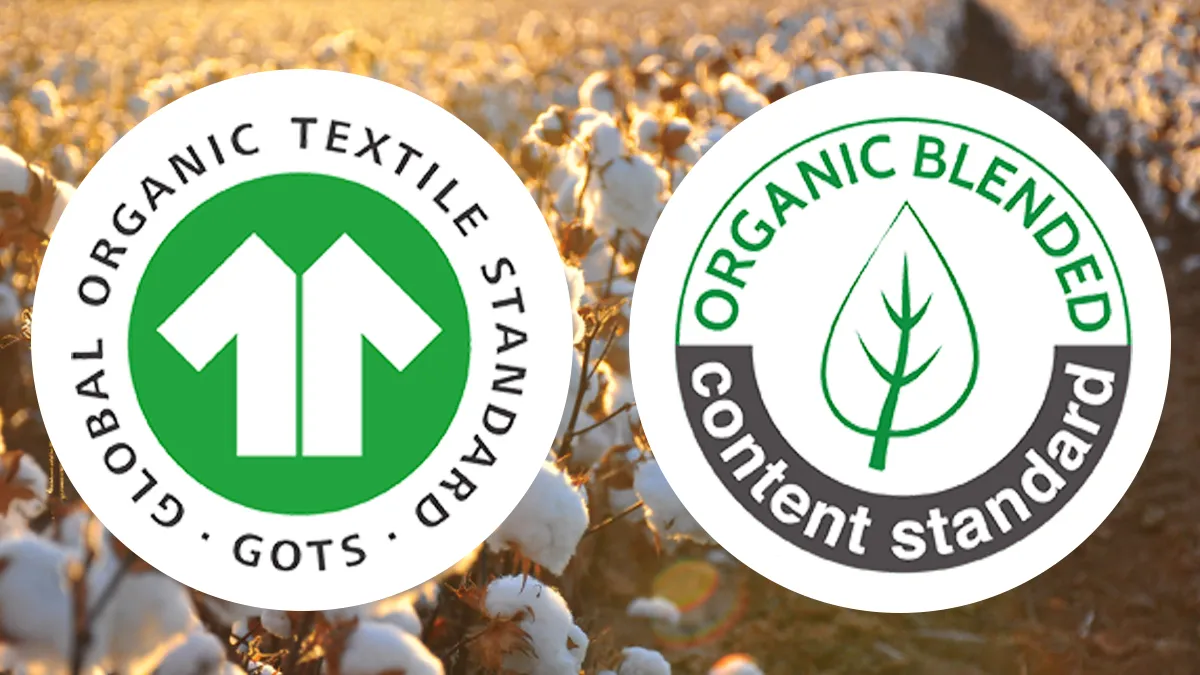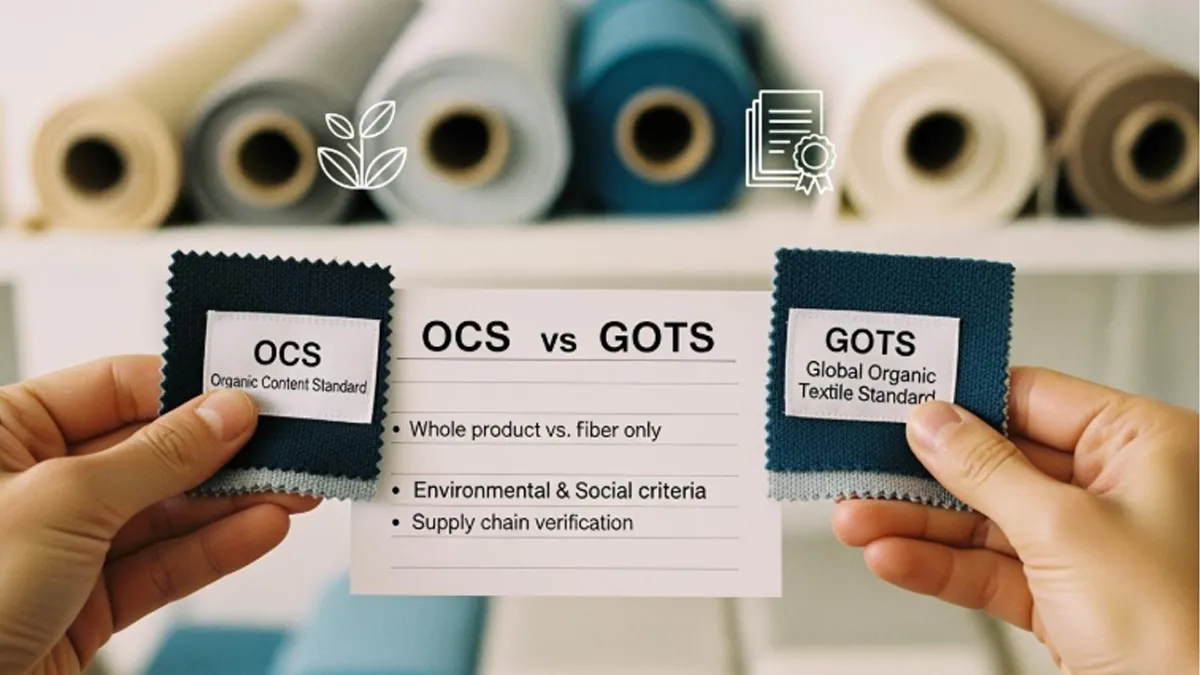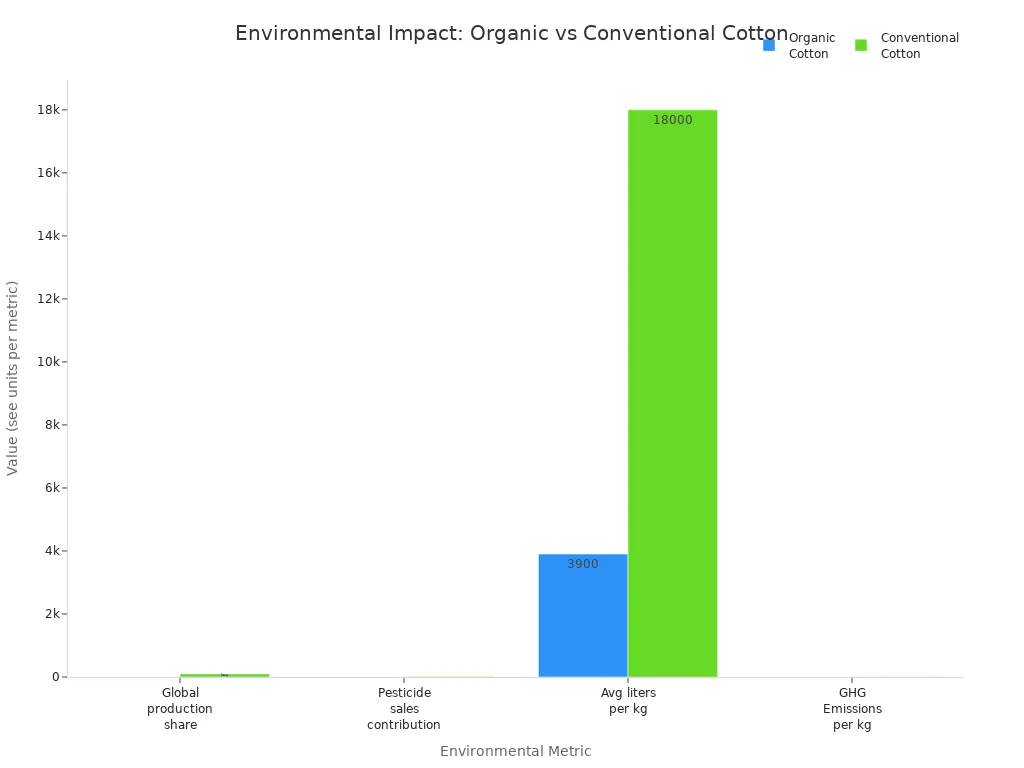
When you compare ocs vs gots, you see two top certifications for organic textiles. They are both important, but they do different things. OCS checks the amount of organic content in products. It also helps track where the materials come from. GOTS has strict rules for the environment and workers. These rules start at the farm and go to the finished textile. Knowing these differences helps you pick products that match your values. You can choose quality and care for the planet. More people want organic materials now. Look at these numbers:
| Statistic | Value |
|---|---|
| Organic Cotton Market Valuation (2021) | $637.1 million |
| Organic Cotton Market Valuation (2028) | $6.73 billion |
| CAGR (2021-2028) | 40.0% |
| US Organic Textile Sales (2021) | $2.3 billion |
| Projected Increase in Demand for Organic Cotton by 2030 | 84% |
You can see why it is important to know about certifications when you buy organic products.
Key Takeaways
- OCS checks how much organic content is in products. GOTS looks at the whole textile process, including rules for the environment and workers.
- Pick GOTS if you want strong rules for the planet and worker safety. OCS is good if you only care about organic content.
- GOTS needs at least 70% organic content in products. OCS only needs 5% organic content. GOTS is better if you want more organic material.
- Both certifications help you make smart choices. GOTS protects the environment and workers more than OCS.
- Check for certification labels when you shop. GOTS labels mean high standards. OCS labels show how much organic content is in the product.
- GOTS makes sure factories are safe and bans harmful chemicals. OCS does not check how products are made.
- You help organic farming when you buy certified products. GOTS and OCS both support organic farming but focus on different things.
- Knowing about these certifications helps you shop by your values. You can choose what matters most, like organic content or fair production.
OCS vs GOTS Overview

Key Differences
When you compare ocs and gots, you see two big standards for organic textiles. Both help you find certified products, but they do not work the same way. OCS stands for Organic Content Standard. It checks how much organic material is in non-food products. GOTS means Global Organic Textile Standard. It covers everything from the farm to the finished textile. You get more than a label. You get a promise about how the product was made.
OCS checks the amount of organic content. It does not check how the product was made or if workers are treated well. You can find OCS on things like bags or cosmetics. GOTS does more. It has rules for the environment and for workers. You see GOTS on clothes, bedding, and towels. GOTS needs at least 70% organic content. OCS only needs 5% organic content. GOTS also limits mixing with other fibers. This gives more protection for organic fibers.
If you want strict rules, GOTS is the better pick. You know the product has organic content, cares for the environment, and protects workers. OCS is good if you just want to know the amount of organic material. It is easier and covers more types of non-food products. You can choose which certification is best for you.
Tip: If you care about every step, pick GOTS. If you only want to check organic content, OCS is enough.
Comparison Table
Here is a quick look at the main differences between OCS and GOTS:
| Aspect | OCS (Organic Content Standard) | GOTS (Global Organic Textile Standard) |
|---|---|---|
| Minimum Organic Content | 5% | 70% |
| Scope | Non-food products, organic content verification | Entire textile supply chain, processing, manufacturing, distribution |
| Environmental Criteria | Not included | Strict requirements for environmental protection |
| Social Criteria | Not included | Worker safety and social responsibility |
| Product Types | Bags, cosmetics, leather, other non-food items | Apparel, bedding, towels, other textiles |
| Blending Restrictions | Allows blending | Restricts blending, up to 10% synthetic or recycled fibers (25% for sports products) |
| Certified Organic Fibers | Verified, but not protected by processing rules | Protected by strict processing and blending rules |
| Certified Products | Many non-food organic products | Textile products made from organic natural fibers |
You can see GOTS covers more things. It checks the organic content, how the product is made, and who makes it. OCS is easier to get, but it does not promise high standards for the environment or workers.
If you want textiles with lots of organic content and strong rules, pick GOTS. If you want to check organic content in more products, OCS is a good choice. Both help you make better choices for yourself and the planet.
OCS Certification
What is OCS
You might wonder what OCS means when you see it on a product label. OCS stands for Organic Content Standard. This is an internationally recognized certification that checks the amount of organic material in products. The main goal is to make sure you can trust the label when it says “organic.” OCS certification helps you know where the organic fibers come from and how much organic content is in the final product. You get peace of mind because the process tracks the organic materials from the farm all the way to the finished item. This system encourages more farmers to grow organic crops and supports the growth of organic agriculture.
Note: OCS certification does not cover how the product is made or how workers are treated. If you want those extra protections, you should look at gots certification.
Certification Process
Getting OCS certification is not as hard as you might think. You follow a clear set of steps to make sure your product meets the standard. Here’s how you do it:
- Understand the Requirements
- Gap Analysis
- Implement Changes
- Documentation
- Internal Audit
- Select a Certification Body
- Apply for Certification
- External Audit
- Certification Decision
You start by learning what OCS asks for. You check your current process and see what needs to change. You make those changes and keep records. You do your own audit to catch mistakes. Then you pick a group that gives out certification. You apply and let them check your work. If you pass, you get OCS certification for your product. This process helps you prove your product has real organic content.
Tip: If you want to compare OCS certification with gots certification, remember that GOTS checks more things, like chemicals and worker safety.
Scope
OCS certification covers many types of products. You see it on bags, cosmetics, and even leather goods. The main thing OCS checks is that the input materials are organically grown. OCS certification follows the supply chain, so you know the organic content stays true from the farm to the finished product. It does not include the first processors, like the cotton gin, but it picks up after that. You get a clear picture of the organic journey. This makes OCS certification a good choice if you want to verify organic content in a wide range of non-food products.
If you care about organic farming and want to support it, OCS certification gives you a way to do that. You get to choose products that help organic farmers and keep the supply chain honest. If you want more rules about how products are made, you might want to look at gots certification instead. Both certifications help you make better choices for yourself and the planet.
GOTS Certification
What is GOTS
You may see the global organic textile standard on lots of products. People call this standard GOTS. It sets rules for making textiles with organic fibers. GOTS certification helps you trust your product. It means your product meets tough requirements. You know it uses certified organic fibers. It also follows safe steps when making the product. GOTS does not just check the raw material. It looks at every step from the farm to the finished item.
Here’s why GOTS is special:
- GOTS is the top standard for processing organic fibers.
- It makes sure products use safe manufacturing and very few chemicals.
- The standard is a global rule for organic textiles.
- GOTS needs at least 70% organic fibers in each product.
- It checks that chemicals follow strict safety and environmental rules.
- The goal is to protect nature and give you safe, high-quality products.
If you want to help organic farming and fair production, GOTS certification is a good choice.
Certification Process
Getting GOTS certification has a few easy steps. You must show your textile products follow all the rules. Here is how you get certified:
- Send an application to a certification group. You share details about your product or facility.
- Get ready for an on-site check. You organize your papers and records.
- Go through the check. The group looks at your process and materials.
- Get your GOTS Scope Certificate. This proves you care about sustainable textiles.
You see these steps in the supply chain:
- First, organic fibers get processed.
- Next, spinning turns fibers into yarn.
- Then, weaving or knitting makes fabric.
- Wet-processing adds color or treats fabric with allowed chemicals.
- Last, manufacturing creates the finished textile goods.
GOTS checks every step. You know your product meets high standards from start to finish.
Tip: Keep your records neat. This makes getting certified much easier.
Scope
GOTS certification covers many organic textile products. You find it on yarns, fabrics, clothes, home textiles, mattresses, hygiene items, and food contact textiles. The standard follows the product from harvesting, through processing and making, to packaging, labeling, and selling. GOTS does not cover leather products.
Here’s a quick look at what GOTS covers:
| Product Types | Supply Chain Stages |
|---|---|
| Yarns | Harvesting of raw materials |
| Fabrics | Processing and manufacturing |
| Clothes | Packaging and distribution |
| Home textiles | Labeling and retail |
| Mattresses | |
| Personal hygiene products | |
| Food contact textiles |
You can trust GOTS certification to protect organic content and make sure production is responsible at every stage. When you pick GOTS certified products, you help the planet and support better working conditions.
Criteria Comparison
Environmental Standards
There is a big difference in environmental rules between these two certifications. GOTS has tough rules for water, waste, and chemicals. You can trust GOTS products to help the planet. GOTS checks that companies use safe chemicals. It makes sure water is managed well. Waste must be handled so it does not hurt nature. You get a product that cares about the earth.
OCS does not have strong environmental rules. OCS looks at where organic content comes from. It checks if a product has organic material. OCS does not make companies follow strict environmental steps. You might see OCS on many things. But it does not promise safe chemicals or good care for water and soil.
Here is a table to help you compare:
| Standard | Environmental Standards | Social Standards | Scope |
|---|---|---|---|
| GOTS | Strict rules for water use, waste, and chemicals | Fair treatment and good working conditions | Covers the whole supply chain |
| OCS | Focuses on traceability of organic content, no strict environmental rules | No social criteria | Only checks organic content |
Tip: Pick GOTS if you want textiles that protect nature. OCS is good if you only care about organic content.
Social Criteria
Social rules matter if you want to help workers. GOTS has strong social standards. Workers get fair treatment and safe places to work. GOTS checks that companies pay fair wages. It does not allow child labor. Workplaces must be safe. When you buy GOTS textiles, you help people and the planet.
OCS does not have social rules. OCS only checks how much organic material is in the product. It does not look at worker safety or fair pay. If you want to support good workplaces, choose GOTS certification.
Here is what each standard gives you:
- GOTS: Fair treatment, safe workplaces, no child labor, and good working conditions.
- OCS: No social rules, only checks organic content.
Note: GOTS helps people and the planet. OCS only checks organic content.
Traceability
Traceability means you know where your textile comes from. Both GOTS and OCS help you track organic content. They do this in different ways.
GOTS lets you follow cotton or other fibers from the farm to the finished product. GOTS checks every step. You know your textile is truly organic and made with care. You get full transparency. This helps you trust what you buy.
OCS also checks traceability of organic content. Every part of the supply chain must be certified. You can call a product organic only if every company meets the rules. OCS uses Trackit to collect data and find problems. This system follows the product from farm to store. Since December 2022, OCS asks for more information. Now, all first processors must be certified. You can trace organic content back to the original farm.
Both standards give strong traceability. GOTS adds more checks for the environment and workers. OCS gives a clear record of organic content. But it does not check how the product is made or who makes it.
If you want to know your textile is organic and made right, GOTS gives the most complete picture. OCS is best if you only want to check traceability of organic content.
Labeling
When you shop for organic textiles, the label tells you a lot. You want to know what you are buying. Both OCS and GOTS have clear rules for labels. These rules help you trust the product.
GOTS labels show you the grade of organic content. You might see “Organic” or “Made with ___% Organic Materials.” The label grade depends on how much organic fiber the product has. Here’s a quick look:
| Label Grade | Organic Content |
|---|---|
| Organic | At least 95% organic fiber |
| Made with ___% Organic Materials | Between 70% and 94% organic fiber |
OCS labels work in a similar way. You will see the percentage of organic content right on the label. This makes it easy to compare products. If a product has 85% organic cotton, the label will say “Made with 85% Organic Materials.” You do not have to guess.
You will also find other important details on GOTS and OCS labels:
- The label grade (like Organic or Made with 85% Organic Materials)
- The phrase “Certified by [Name of Certifier]” (for example, Certified by OTCO)
- The GOTS license number or OCS certification number
These details help you check if the product is really certified. You can look up the license number in the public database. This gives you extra peace of mind.
Tip: Always read the label. Look for the certifier’s name and the license number. This helps you avoid fake claims.
Labels do more than just show the organic content. They tell you if the product meets strict rules. GOTS labels mean the product follows tough standards for the environment and workers. OCS labels mean the product has a verified amount of organic material. When you see these labels, you know what you are getting.
If you want the highest level of trust, pick products with clear, complete labels. This way, you support honest brands and make better choices for yourself and the planet.
Impact on Quality
Material Purity
When you buy organic textiles, you want to know what touches your skin. OCS and GOTS help you trust your products. These certifications show that your textiles follow strict organic rules. You do not have to wonder if your shirt or bag is really organic.
GOTS goes even further for purity. This standard makes sure your textiles use organic fibers. It also keeps out harmful chemicals. GOTS checks every dye and chemical used. It does not allow toxic things like heavy metals or formaldehyde. You get textiles that are safer for you and the planet.
OCS helps keep things pure too. It tracks organic content through the supply chain. You know your product did not mix with non-organic materials. Both OCS and GOTS lower the risk of contamination. They make sure everyone in the supply chain follows the rules.
Here’s what these certifications do for you:
- Help you trust the organic label.
- Lower the chance of mixing with non-organic stuff.
- Show that brands care about your health and the earth.
- Let you pick products that are truly honest.
Tip: Always look for OCS or GOTS labels if you want pure textiles.
Manufacturing
How your textiles are made is important too. GOTS and OCS set rules for factories and workers. GOTS does more, but both help improve quality.
GOTS checks every step in making your textiles. Factories must use only approved chemicals. These chemicals are on a special list called the Restricted Substances List (RSL). GOTS also cares about people. Workers must be treated fairly and work in safe places. Factories must manage waste and water to protect nature. Even the oils in machines cannot have heavy metals if they touch your textiles.
OCS focuses more on tracking organic content. But it still asks factories to keep good records. Factories must track how much organic material they use and move. This helps stop mistakes and keeps your product honest.
Here’s a quick table to show what GOTS expects from manufacturers:
| Manufacturing Practice | What It Means for You |
|---|---|
| Approved Chemicals | Only safe chemicals touch your textiles |
| Social Criteria | Workers get fair treatment |
| Environmental Management | Factories protect air, water, and soil |
| Heavy Metal-Free Oils | No toxic oils near your organic fibers |
| Record Keeping | Every step is tracked and checked |
| Certified Weight | You get what the label promises |
| Labeling Approval | Labels are checked before they reach you |
When you pick GOTS or OCS certified products, you support better manufacturing. You get textiles that are safer, cleaner, and made with care. That is quality you can feel.
Sustainability and Ethics
Environmental Impact
You might ask how organic textiles help the earth. When you buy products with OCS or GOTS, you support farms that use fewer chemicals and less water. These standards want better ways to grow and make textiles. This helps lower pollution and greenhouse gases.
Let’s see how organic cotton compares to regular cotton:
| Metric | Organic Cotton | Conventional Cotton |
|---|---|---|
| Global production share | 1.4% | 98.6% |
| Contribution to pesticide sales | <1% | 16% globally |
| Total water footprint | Significantly lower | Highest among major crops |
| Average liters per kg | ~1,800 – 6,000 liters | ~7,000 – 29,000 liters |
| Water pollution risk | Very low | High (pesticide & fertilizer runoff) |
| GHG Emissions/kg fiber | 1.8 – 2.5 kg CO₂e | 3.5 – 4.5 kg CO₂e |
| Soil erosion | Reduced | Severe (intensive tilling) |
| Pesticide usage | None (synthetic) | 10% of global pesticides used for cotton |

Organic cotton uses much less water than regular cotton. It does not use synthetic pesticides or fertilizers. This means rivers and lakes stay cleaner. Greenhouse gas emissions are also lower. The soil stays healthy because organic farms do not use harsh chemicals or heavy plowing. When you pick textiles with these standards, you help protect nature for the future.
Social Responsibility
You want workers to be treated well. GOTS makes sure workers have fair treatment. These rules follow the International Labour Organization. Workers get safe and clean places to work. They earn fair pay and work normal hours. No forced labor or child labor is allowed.
Here’s a quick look at how the two certifications compare:
| Certification | Social Responsibility Criteria |
|---|---|
| GOTS | No forced or child labour, safe and hygienic working conditions, fair wages, reasonable working hours |
| OCS | Primarily focuses on tracking organic status, lacks broader social criteria |
GOTS cares about people and the planet, not just organic content. OCS checks organic content but does not have rules for worker rights.
- GOTS certification uses social rules from ILO conventions.
- It makes sure workers have safe and clean workplaces.
- It requires fair pay and normal work hours.
When you choose GOTS, you help workers and the earth. OCS helps you trust the organic content, but GOTS gives you more peace of mind about how people are treated.
Choosing Certification
When you pick a certification for organic textiles, think about what you want. Your choice between GOTS certification and the organic content standard can change your brand, store, or shopping habits. Let’s see what is important for brands, stores, and shoppers.
For Brands
If you have a brand, you want your products to be special. You also want to show you care about people and the earth. GOTS certification checks more than just organic content. It looks at how you treat workers and the environment. This certification is known for being very complete for organic cotton. It helps you earn trust from customers who want safe and fair products.
The organic content standard checks how much organic material is in your products. It does not check how you make things or treat workers. If you only need to prove the amount of organic content, this certification is good. But if you want to show you care about the planet and people, GOTS certification is better. Think about what your customers want and what your brand means.
Tip: Pick GOTS certification if you want your products to have a strong ethical story. If you just need to check organic content, the organic content standard is enough.
For Retailers
If you run a store, you want to sell products your customers trust. You also want to make sure your supply chain is honest. GOTS certification gives you peace of mind. It covers organic fibers, strict rules for the environment, and fair treatment for workers. You can tell your customers your products meet high standards.
The organic content standard is easier to get. It helps you sell many products with checked organic content. If your customers care most about knowing the organic content, this certification is a good choice. But if they want strong rules for the planet and workers, GOTS certification is better.
Here’s a quick table to help you choose:
| Your Priority | Best Certification |
|---|---|
| Full sustainability & ethics | GOTS certification |
| Simple organic content check | Organic content standard |
For Consumers
You want to buy things that match your values. You also want to know what you are getting. Here’s how you can pick between GOTS certification and the organic content standard:
- Look for the label. Check for GOTS certification or the organic content standard on the product.
- Read the details. See if the product says how much organic content it has.
- Ask questions. Talk to the seller about the certification and where the organic content comes from.
If you want the highest standards for organic, the planet, and workers, pick GOTS certification. If you only care about the amount of organic content, the organic content standard is enough. Both help you make better choices for yourself and the earth.
Remember: The best certification depends on what matters most to you—purity, ethics, or both.
Certified Packaging Solutions
Importance
You want your organic textiles to stay real from start to end. Certified packaging is very important for this. When you see a certified label on packaging, you know the product is what it says. This helps you trust what you buy.
Let’s see why certified packaging matters for OCS and GOTS:
| Key Point | Explanation |
|---|---|
| Ensures Transparency | Certified packaging proves products are real and not fake. |
| Supports Traceability | It helps you follow the product’s path and keeps standards high. |
| Guarantees Compliance | Certification checks paperwork and traders to keep things honest. |
Certified packaging is more than just a box or bag. It gives you peace of mind. It shows every step, from farm to store, follows strict organic rules. You can feel good knowing your choice supports honest brands.
Here are some reasons certified packaging is important:
- It helps you trust the organic quality of textiles.
- It stops brands from making false claims.
- It makes it easier to check the whole supply chain.
If you care about organic products, you want packaging that fits your values. Certified packaging helps you make smart choices and keeps the market fair.
Sourcing
You might wonder how to get certified packaging for your organic textiles. The first step is picking suppliers who know the certification rules. You need to work with companies that follow OCS or GOTS for packaging.
Here’s how you can find certified packaging:
- Find suppliers with real certification for packaging.
- Make sure they use organic materials if needed.
- Ask for papers that prove their certification.
- Check that every step in the supply chain can be tracked.
- Use the Global Trace Base to follow your packaging from start to end.
When you use certified packaging, you protect your brand and your buyers. You keep the chain of custody strong for organic textiles. You also help stop fake claims because everything gets checked.
Tip: Always ask for proof of certification before picking a packaging supplier. This keeps your products real and your customers happy.
If you want to help organic farming and fair business, certified packaging is the best choice. You help build a better supply chain and make sure every product meets high standards.
Conclusion
When you compare ocs and gots, you notice they are not the same. Here is a simple table to show the main differences:
| Aspect | OCS Certification | GOTS Certification |
|---|---|---|
| Focus | Organic content only | Organic, environment, and social standards |
| Products | Non-food items | Textiles with organic fibers |
Picking ocs or gots changes how people see your brand. You can show you care about the planet and gain trust from buyers. This helps you find new customers who want eco-friendly products. If you need help with ocs or gots packaging, wholesale, or custom bags, our team is here for you.
FAQ
What does OCS stand for?
OCS means Organic Content Standard. You see this label on products that use organic materials. OCS checks the amount of organic content in non-food items, like bags or cosmetics.
What does GOTS stand for?
GOTS stands for Global Organic Textile Standard. This certification covers the whole process, from farm to finished textile. You get strict rules for organic content, the environment, and worker safety.
Can a product have both OCS and GOTS certification?
Yes, some products can carry both certifications. You might see this if a brand wants to show organic content (OCS) and also meet strict environmental and social rules (GOTS).
How do I check if a product is really certified?
Look for the certification label and the certifier’s name. You can also check the license number online. This helps you avoid fake claims and trust what you buy.
Which certification is better for the environment?
GOTS is better for the environment. It has strict rules for chemicals, water use, and waste. OCS only checks organic content and does not cover environmental steps.
Do these certifications cost more for brands?
Yes, getting certified costs money. Brands pay for audits and paperwork. Many brands think it is worth it because you trust their products more.
Can I find these certifications on packaging?
You can find OCS and GOTS labels on packaging, too. Certified packaging helps keep the supply chain honest and protects the organic status of your textiles.




